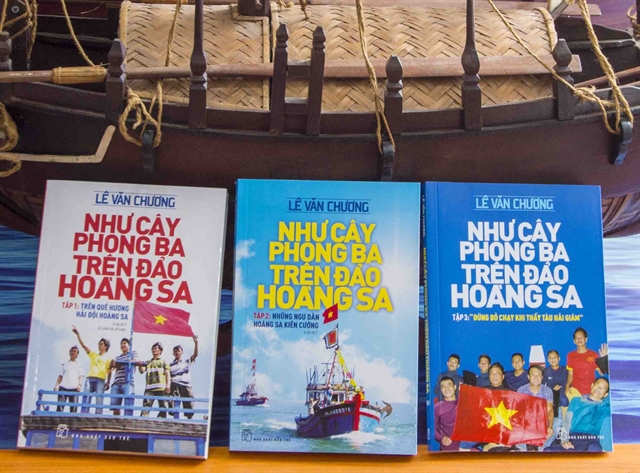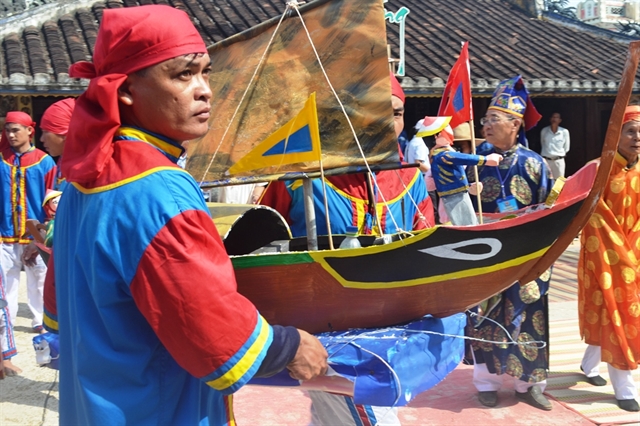Weather:
- Ha Noi 23oC
- Da Nang 26oC
- Ho Chi Minh 27oC

Journalist Lê Văn Chương has introduced the third volume of his three-part book entitled Như Cây Phong Ba Trên Đảo Hoàng Sa (Stand Strong as the Phong Ba Tree on the Hoàng Sa Islands) after the first two volumes were published in 2013 and 2015.
Chương, 49, who works at the branch office of the Bộ Đội Biên Phòng (Border Guard) newspaper in Quảng Ngãi Province, spent 15 years to research and collect information from working trips to the Hoàng Sa (Paracels) waters with local fishermen to complete the third 288-page final volume of the series.
The three-volume book, which was published recently by the Trẻ (Youth) Publishing House, is seen as one of the most detailed records of the real lives of local fishermen working in the waters of the Hoàng Sa -- one of the largest and richest fishing grounds of Việt Nam, and a place where their ancestors practised the fishing trade for centuries – and the traditional fishing lifestyle and ancient culture.

The first volume of Như Cây Phong Ba Trên Đảo Hoàng Sa, with the subtitle Trên Quê Hương Hải Đội Hoàng Sa (The Homeland of the Hoàng Sa Flotilla) features old culture, ancient documents, temples, pagodas and festivals in the Lý Sơn Islands off the coast of Quảng Ngãi, the Hoàng Sa Islands, the Hoàng Sa Flotilla and the preservation of the annual Hoàng Sa Flotilla Festival.
The flotilla was set up by the Nguyễn Dynasty to patrol the Hoàng Sa and Trường Sa (Spratly) archipelagos and salvage goods from boat wrecks, catch fish and protect the nation's territorial waters.
The festival, which includes a requiem for those who had died on sea patrol missions, a procession of four supernatural creatures and the release of lanterns, was recognised as a National Intangible Heritage.
Lý Sơn Island, 30km offshore Quảng Ngãi Province, still preserves the Âm Linh Pagoda, a place of worship for seamen dispatched to protect the Paracel Islands since the 17th century during the reign of the Nguyễn Dynasty.
“I have studied the history of the Hoàng Sa Islands since 1994, but my official research only started in 2006. The first volume of my book was printed by the Trẻ (Young) Publishing House in 2013. It has been reprinted three times since then,” Chương said.
“The Vietnamese mariners of the Hoàng Sa Flotilla made regular patrols of the islands on junk boats from the 17th century, and many of them died due to rough seas or serious illness. Their bodies were dropped into the sea, but their spirits were preserved in 'wind graves' built by the local authorities and their relatives on the Lý Sơn Island,” he explained.

The second 340-page volume, with the subtitle Những Ngư Dân Kiên Cường (Brave Fishermen), was published in 2015 and honours fishermen of Quảng Ngãi and other central coastal provinces for their persistent fishing in the Hoàng Sa waters from generation to generation.
“Despite risky sea trips, local fishermen still make their living from fishing off the Hoàng Sa and they live as strongly as phong ba trees on the islands. The work routine of the local fishing community helps reconfirm the country’s sovereignty on the islands and seas,” he said.
The author likened the Vietnamese fishermen to the phong ba tree (scientifically named Heliotropium foertherianum) for its resistance to harsh climate on the islands in the East Sea (internationally known as the South China Sea).
Chương, who acted as a scout of the Border Guard in supporting fishermen with long trips to the Hoàng Sa seas before taking journalism as a career in 2012, said he had many times witnessed fishermen returning from disasters at sea.
“At least 400 trawlers from Quảng Ngãi often fish in the waters off the Hoàng Sa. Each trip could take them a month. Our Border Guard and Coast Guard ships are always ready to help fishermen in distress at sea,” he said.
In the third volume of the book, Chương sent a strong message to local fishermen dealing with potential dangers of being disturbed or even attacked by Chinese maritime surveillance ships while fishing in the Hoàng Sa seas.
"Đừng Bỏ Chạy Khi Thấy Tàu Hải Giám (Don’t Run Away when Facing Chinese Surveillance Ships) is the subtitle of the third volume,” he wrote.
“Fishermen should not run away when Chinese ships disrupt their work in the Hoàng Sa waters,” Chương stressed.

Despite the Hoàng Sa Islands being illegally taken by force by Chinese troops in 1974, fishermen from Quảng Ngãi have kept up fishing in the area.
Chương said that fishermen from Quảng Ngãi, Quảng Nam, Quảng Bình, Quảng Trị, Thừa Thiên Huế, Phú Yên, Bình Định, Ninh Thuận, Bình Thuận and Bà Rịa-Vũng Tàu should support each other from the dangers of natural disasters or threats by foreign ships.
According to the Border Guard, 248 Vietnamese trawlers from Bình Định, Quảng Nam and Quảng Ngãi were either seized or attacked by Chinese surveillance ships while fishing in the Hoàng Sa Islands waters during the period from 2006 to 2017. All assets, fish and boat equipment on these boats were taken by Chinese surveillance ships. VNS


